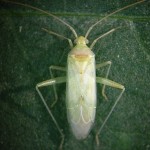Mirids (Creontiades dilutus, C. pacificus) in summer pulses – mungbean, navy bean, adzuki bean, faba bean, peanut and soybean. They are also a pest in cotton.
| Seedling/Vegetative | Budding/Flowering/Podset | Podfill and Podripening/Harvest | |||
|---|---|---|---|---|---|
| Insects and damage |
|
Mungbeans, navy beans and adzukis are highly susceptible. Peanuts and soybeans are far more tolerant. Budding, flowering and early-podding crops are at greatest risk. Populations typically increase rapidly due to in-crop breeding.
Damage includes flower and bud abortion. Mirids release a chemical while feeding that destroys cells in the feeding zone causing black spots. |
Mungbeans, navy beans and adzukis remain at risk- mirids attack late buds/flowers.
Soybeans/peanuts are not at risk. |
||
| Monitoring | Populations are influenced by climatic conditions:
Numbers may be lower after heavy rains or storms, though storm fronts may also bring influxes of adults. Mirid migrations from inland areas are associated with weather fronts. Mirids can also move in from surrounding crops and weed hosts early in the summer. Monitor twice weekly using a beat sheet from budding to early podding. Sample 5 one-metre lengths of row (non consecutive) within a 20 m radius, from at least six sites throughout a crop. Avoid sampling in very windy weather as mirids are easily blown off the sheet. Record the numbers of mirid nymphs and adults, and number and types of beneficial insects. |
||||
| Beneficials | Predatory bugs (damsel bugs, big-eyed bugs, predatory shield bugs) as well as ants and lynx, night stalker and jumping spiders feed on mirid adults, nymphs and eggs. | ||||
| Cultural control |
|
||||
| Thresholds | Mungbeans: Thresholds vary from 0.3-0.6/m2, depending on application costs and commodity prices. Note that the mirid thresholds are based on continuous mirid activity at the above levels over a 28-day period. Find economic thresholds for mirids in the ready reckoner for mirids in mungbeans.
Peanuts and Soybeans: Only spray if populations exceed 5/m2. Populations up to this level have not reduced yield in field trials. |
||||
| Pesticides |
|
||||
| Multi-pest considerations |
|
||||
| Communication | Discuss spray management plans with neighbours and consultants (see area wide management)
Industry publications can provide up to date information about regional pest issues. |
||||
Further information
Mirids (DAF Queensland)
Plant bugs (PDF – DPI NSW)
Certified Mungbean agronomy course – Australian Mungbean Association
Pests and Beneficials in Australian Cotton Landscapes (CottonInfo)

